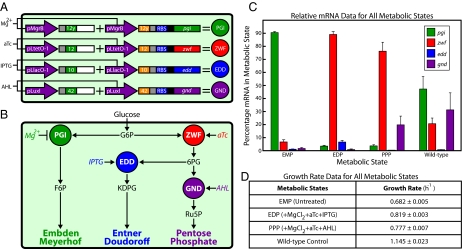Fig. 4.
Metabolism switchboard. (A) Metabolism switchboard schematic. (B) Overview of glucose-utilization pathways controlled by our metabolism switchboard (27). Glucose imported into the cell is converted quickly to glucose-6-phosphate (G6P). Phosphoglucose isomerase (Pgi; green), regulated here by Mg2+-sensitive pMgrB, converts G6P to fructose-6-phosphate (F6P), which is the first step in the EMP. Glucose-6-phosphate dehydrogenase (Zwf; red), regulated here by aTc-sensitive PLtetO-1, converts G6P to 6-phosphogluconolactone, which then is converted to 6-phosphogluconate (6PG) by 6-phosphogluconolactonase (Pgl; not shown). Phosphogluconate dehydratase (Edd; blue), regulated here by IPTG-sensitive PLlacO-1, converts 6PG to 2-keto-3-deoxy-6-phosphogluconate (KDPG), which is the first of only two steps in the EDP. 6-Phosphogluconate dehydrogenase (Gnd; purple), regulated here by AHL-sensitive pLuxI, converts 6PG to ribulose-5-phosphate (Ru5P), which is the distinguishing step in the PPP. (C) Metabolism switchboard performance at the RNA scale. Relative mRNA concentrations for the target metabolic genes, presented as the percentage of the total of all switchboard-regulated mRNA for each metabolic state. (D) Exponential growth rates per hour. The graph in C and table in D depict the triplicate mean ± SEM.

